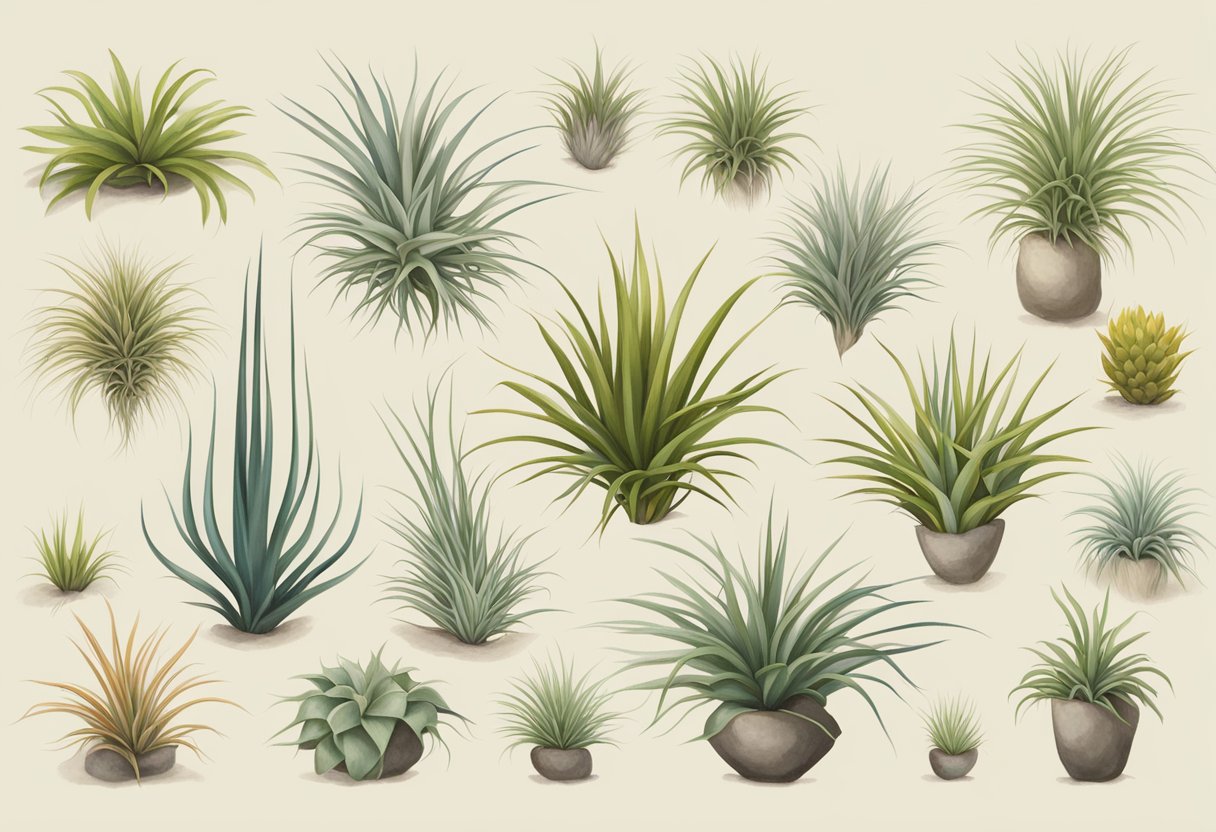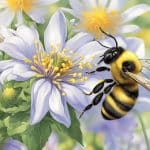Types Of Air Plants
Air plants, also known as Tillandsia, are unique plants that belong to the Bromeliad family. They are epiphytes, which means that they grow on other plants or objects without relying on soil for nutrients. Air plants are known for their unique appearance and low maintenance requirements, making them a popular choice among indoor gardeners.
Basic Characteristics of Air Plants
Air plants come in a variety of shapes, sizes, and colors. They typically have narrow, strap-like leaves that grow in a rosette pattern, with new growth appearing from the center. Some air plants have silvery foliage, while others have green leaves. All air plants have tiny hairs covering their leaves, known as trichomes, which help them absorb water and nutrients from the air.
Caring for Air Plants
Air plants are relatively easy to care for and require minimal attention. They thrive in bright, indirect light and should be watered once a week by soaking them in water for 20-30 minutes. After soaking, air plants should be allowed to dry completely before being returned to their display. Air plants do not require soil, but they can benefit from occasional fertilization with a balanced, water-soluble fertilizer.
Key Takeaways
- Air plants are epiphytes that grow on other plants or objects without relying on soil for nutrients.
- They come in a variety of shapes, sizes, and colors and require minimal care.
- Air plants thrive in bright, indirect light and should be watered once a week by soaking them in water for 20-30 minutes.
Basic Characteristics of Air Plants

Air plants, also known as epiphytes, are a type of plant that grows without soil. They are a diverse group of plants that belong to the Bromeliaceae family and are native to tropical and subtropical regions of the Americas. In this section, we will discuss the basic characteristics of air plants, including their species diversity, physical attributes, and growth and reproduction.
Species Diversity
There are over 600 species of air plants, and they come in a wide range of shapes, sizes, and colors. Some species are small and delicate, while others are large and robust. They can be found growing on trees, rocks, and other surfaces in their natural habitats. Some of the most popular species of air plants include Tillandsia ionantha, Tillandsia xerographica, and Tillandsia stricta.
Physical Attributes
Air plants have unique physical attributes that allow them to survive without soil. They have small roots that are used to anchor themselves to their growing surface, but they do not absorb nutrients from the soil. Instead, they absorb moisture and nutrients through their leaves. Their leaves are covered in trichomes, which are small, hair-like structures that help them absorb water and nutrients from the air. Air plants also have silvery-green rosettes that can be used to store water.
Growth and Reproduction
Air plants grow slowly and can take several years to reach their full size. They reproduce by producing offsets or pups, which are small plants that grow from the base of the parent plant. These offsets can be removed and planted to grow into new plants. Air plants also produce blooms, which can be a range of colors, including pink, purple, and red. The blooms are often fragrant and can last for several weeks.
In conclusion, air plants are a fascinating group of plants that have adapted to survive without soil. They come in a wide range of species and have unique physical attributes that allow them to absorb moisture and nutrients from the air. They grow slowly and reproduce by producing offsets and blooms.
Caring for Air Plants
Air plants are low-maintenance plants that can survive without soil. However, they still need proper care to thrive. Here are some tips on how to care for air plants:
Watering Techniques
Air plants absorb water through their leaves, so it’s important to keep them hydrated. One way to water air plants is to soak them in water for 30 minutes to an hour once a week. After soaking, shake off excess water and let them dry completely before putting them back in their display. Alternatively, you can mist them with water once or twice a week, making sure to cover all parts of the plant.
Light and Temperature Requirements
Air plants need bright, indirect light to thrive. They should be placed near a window that gets plenty of natural light but not direct sunlight. Air plants also prefer temperatures between 50-90¬∞F, so it’s important to keep them away from cold drafts or extreme heat.
Display and Mounting Options
Air plants can be displayed in a variety of ways. They can be placed in a decorative dish, hung from a string or wire, or mounted on a piece of driftwood or other decorative object. When mounting air plants, make sure to use a non-toxic adhesive that won’t harm the plant. It’s also important to provide good air circulation around the plant to prevent rot.
In summary, air plants are easy to care for as long as they are given the right conditions. Water them regularly, provide them with bright, indirect light, and display them in a way that allows for good air circulation. With proper care, air plants can thrive and add a unique touch to any home or office.
Popular Air Plant Varieties
Air plants, also known as Tillandsia, are unique plants that require no soil for their roots. They extract moisture from the air and are known as epiphytes. In this section, we will explore some of the most popular air plant varieties.
Tillandsia Ionantha
Tillandsia Ionantha, commonly referred to as the sky plant, is one of the most popular air plant varieties. It has bright blooms during its last living days, with glossy greenish-silver foliage enhancing its beauty. Being a bromeliad, it has short stems and does well in a tropical climate. This type of air plant is easy to care for and is perfect for beginners.
Tillandsia Xerographica
Another popular air plant variety is the Tillandsia Xerographica. Although it is one of the most popular varieties of air plants in the United States, it does not grow wild here. Rather, it originates from the countries of Mexico, El Salvador, Guatemala, and Honduras. This air plant has long, curly leaves that give it a unique appearance. It is also known for its ability to absorb moisture and nutrients from the air, making it easy to care for.
Tillandsia Cyanea
Tillandsia Cyanea, also known as the pink quill plant, is a beautiful air plant variety that produces a bright pink inflorescence. It is a relatively small plant that grows up to 12 inches in height. This air plant is native to Ecuador and is known for its ability to thrive in high humidity environments.
Tillandsia Aeranthos
Tillandsia Aeranthos is a popular air plant variety that is native to South America. It has long, slender leaves that can grow up to 10 inches in length. This air plant produces beautiful purple flowers that bloom in the summer months. It is easy to care for and is perfect for beginners.
Other popular air plant varieties include Tillandsia Caput-Medusae, which has a unique appearance with its curly leaves, and Tillandsia Cotton Candy, which has soft, fluffy leaves that resemble cotton candy.
In conclusion, air plants are unique and fascinating plants that come in a variety of shapes, sizes, and colors. With proper care, they can thrive in any environment and make a great addition to any home or office.
Designing with Air Plants
Air plants are versatile and can be used in a variety of creative ways to enhance the aesthetic appeal of any space. Here are some ideas for designing with air plants.
Terrariums and Containers
Air plants can be placed in terrariums or containers to create a beautiful and unique display. Terrariums can be made from a variety of materials such as glass, metal, and wood. Containers can be anything from mason jars to repurposed teacups. Adding driftwood or other natural elements can create a more organic feel to the display.
Companion Plants and Accessories
Air plants can be paired with other plants such as cacti or succulents to create a stunning display. Accessories such as miniature figurines or decorative stones can be added to further enhance the display. Wreaths made from air plants can be hung on walls or doors to create a unique and eye-catching decoration.
When it comes to designing with air plants, the possibilities are endless. They can be used to add a touch of greenery to any space and can be incorporated into any style of home decor. With a little creativity and imagination, air plants can be transformed into a beautiful and unique display that is sure to impress.
Propagation and Maintenance
Propagating New Plants
Air plants are unique in that they can be easily propagated by using their offsets, or pups. These are smaller plants that grow from the base of the parent plant. To propagate a new air plant, simply wait until the pup is about 1/3 the size of the parent plant, and then remove it by gently pulling it away from the parent.
Once you have removed the pup, you can either plant it in soil or place it in a new location without soil. If you choose to plant it in soil, use a well-draining soil mix. If you choose to grow it without soil, you can place it in a decorative container with rocks or other decorative items.
It’s important to note that air plants can also be propagated from seeds. To do this, prepare a well-ventilated area for the seeds to grow. Moisten a substrate, such as coconut coir, and spread the seeds onto it. Keep the substrate constantly moist and maintain a humid environment to encourage germination.
Common Pests and Issues
Air plants are generally low maintenance, but they can still fall victim to pests and issues. One common issue is overwatering, which can cause the plant to rot. To avoid this, make sure to allow the plant to dry out completely before watering again.
Another issue is ants, which are attracted to the sweet nectar produced by the plant. To prevent ants, simply soak the plant in water for a few hours, which will wash away the nectar.
Common pests that can affect air plants include mealybugs and spider mites. To get rid of these pests, you can use a mixture of water and dish soap, or a commercial insecticide. It’s important to follow the instructions on the insecticide carefully to avoid damaging the plant.
In summary, air plants are easy to propagate using their offsets or by growing them from seeds. They are generally low maintenance, but can still be affected by overwatering, ants, and pests. By following proper plant care techniques and addressing any issues promptly, you can enjoy these unique and fascinating plants for years to come.






